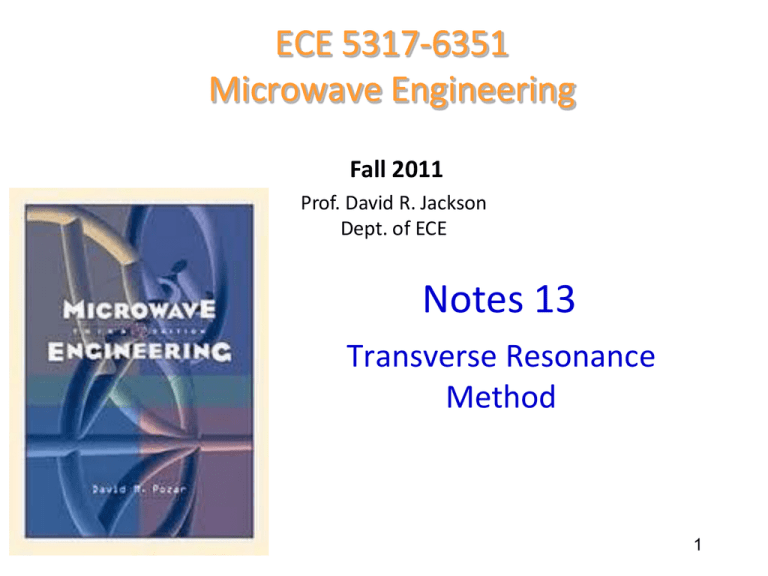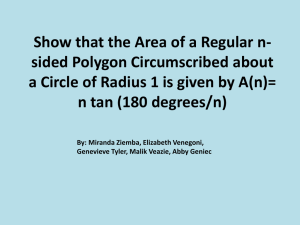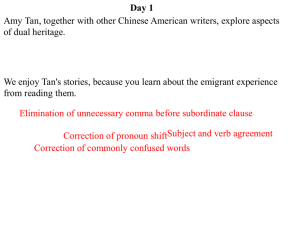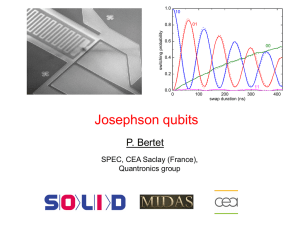Transverse resonance method
advertisement

ECE 5317-6351 Microwave Engineering Fall Fall2011 2011 Prof. David R. Jackson Dept. of ECE Notes 13 Transverse Resonance Method 1 Transverse Resonance Method This is a general method that can be used to help us calculate various important quantities: Wavenumbers for complicated waveguiding structures (dielectricloaded waveguides, surface waves, etc.) Resonance frequencies of resonant cavities We do this by deriving a “Transverse Resonance Equation (TRE).” 2 Transverse Resonance Equation (TRE) To illustrate the method, consider a lossless resonator formed by a transmission line with reactive loads at the ends. R Z L1 jX L1 Z0 x Z0 x = x0 Z L 2 jX L 2 x=L R = reference plane at arbitrary x = x0 We wish to find the resonance frequency of this transmission-line resonator. 3 TRE (cont.) R Z L1 jX L1 Z0 Z0 x x = x0 Z L 2 jX L 2 x=L Examine the voltages and currents at the reference plane: Il R Ir + Vr - + Vl x = x0 4 TRE (cont.) Il R Ir + Vr - + Vl - Z in Define impedances: r V Z in r I Vl Z in l I x x = x0 Z in Boundary conditions: V V r l Hence: Z in Z in Ir Il 5 TRE (cont.) R Z in Z in TRE Z in Z in or Y in Y in Note about the reference plane: Although the location of the reference plane is arbitrary, a “good” choice will keep the algebra to a minimum. 6 Example Derive a transcendental equation for the resonance frequency of this transmission-line resonator. L Z0 , k k0 r Z L1 jX L1 Z L 2 jX L 2 x We choose a reference plane at x = 0+. 7 Example (cont.) L Z L1 jX L1 R Z0 , k k0 r Z L 2 jX L 2 x Apply TRE: Z in Z in Z L 2 jZ 0 tan L Z L1 Z 0 Z 0 jZ L 2 tan L 8 Example (cont.) Z L 2 jZ 0 tan L Z L1 Z 0 Z 0 jZ L 2 tan L jX L 2 jZ 0 tan L jX L1 Z 0 Z j jX tan L 0 L2 jX jZ tan k L L2 0 0 r jX L1 Z 0 Z j jX tan k L L2 0 r 0 jX L1 Z0 j jX L 2 tan k0 L r Z jX 0 L2 jZ0 tan k0 L r 9 Example (cont.) After simplifying, we have tan k0 L r Z0 X L 2 X L1 X L1 X L 2 Z02 Special cases: X L1 X L 2 0 X L1 0, X L 2 k0 L r n k0 L r 2n 1 / 2 10 Rectangular Resonator Derive a transcendental equation for the resonance frequency of a rectangular resonator. z PEC boundary Orient so that b < a <h h r , r y a x b The structure is thought of as supporting RWG modes bouncing back and forth in the z direction. We have TMmnp and TEmnp modes. The index p describes the variation in the z direction. 11 Rectangular Resonator (cont.) z We use a Transverse Equivalent Network (TEN): PEC boundary h h r , r y a Z0 , k z z kz k x b We choose a reference plane at z = 0+. mn z m, n Z0 ZTE ,TM Z in Z in Z in 0 (PEC bottom) Hence Z in 0 12 Rectangular Resonator (cont.) Hence z Z in jZ0 tan h 0 PEC boundary h y m,n m, n jZTE tan k h 0 ,TM z r , r a x b tan k z m,n h 0 h kz m,n h p , p 1,2 Z0 , k z m n 2 h k p a b 2 2 z 13 Rectangular Resonator (cont.) z Solving for the wavenumber we have m n p k a b h 2 2 PEC boundary 2 r , r h y a x b Hence m n p r r a b h 2 2 f mnp 0 0 2 Note: The TMz and TEz modes have the same resonance frequency. 2 TEmnp mode: or f mnp c 2 1 r r m n p a b h 2 The lowest mode is the TE101 mode. 2 2 m 0,1, 2, n 0,1, 2, p 1, 2, m, n 0, 0 c 2.99792458 108 [m/s] 14 Rectangular Resonator (cont.) z TE101 mode: c 1 f101 2 r r 2 1 1 a h PEC boundary 2 h r , r y a x b x z H z x, y, z H 0 cos sin a h Note: The sin is used to ensure the boundary condition on the PEC top and bottom plates: Hn H z 0 The other field components, Ey and Hx, can be found from Hz. 15 Rectangular Resonator (cont.) z Practical excitation by a coaxial probe PEC boundary h r , r y a x b Lp (Probe inductance) R L C Circuit model Tank (RLC) circuit 16 Rectangular Resonator (cont.) Z RLC R 1 j 2 Q 1 0 Q 0 Q = quality factor of resonator 0 U Pdave U U E U H energy stored 1 LC Pdave average power dissipated Lp (Probe inductance) R L C R Q 0 L Circuit model Tank (RLC) circuit 17 Rectangular Resonator (cont.) Z RLC R 1 j 2 Q 1 0 Z RLC RRLC f f0 X RLC 18 Grounded Dielectric Slab Derive a transcendental equation for wavenumber of the TMx surface waves by using the TRE. x h r , r z Assumption: There is no variation of the fields in the y direction, and propagation is along the z direction. 19 Grounded Dielectric Slab x TMx H r , r E z Z Z TM TM 01 kx1 1 Z TM 00 kx0 0 Ez (defined for a wave going in the x direction) H y 20 TMx Surface-Wave Solution R h TEN: Z01TM Z The reference plane is chosen at the interface. TM 00 x Z01TM kx1 Z00TM 1 kx0 0 k x1 k12 k z 2 1 2 2 k x 0 (k0 k z ) j k z 2 k0 2 j x 0 2 Z in jZ01TM tan(kx1h) Z in Z00TM 21 TMx Surface-Wave Solution (cont.) TRE: Z in Z in jZ01TM tan(kx1h) Z00TM j k x1 1 tan(k x1h) kx0 0 k x1 r j tan(k x1h) kx0 22 TMx Surface-Wave Solution (cont.) Letting k x 0 j x 0 , We have x 0 k z 2 k0 2 k x1 r tan(k x1h) x0 or r k z 2 k0 2 k12 k z 2 tan h k12 k z 2 Note: This method was a lot simpler than doing the EM analysis and applying the boundary conditions! 23









